2001 FORD EXPEDITION window
[x] Cancel search: windowPage 222 of 280
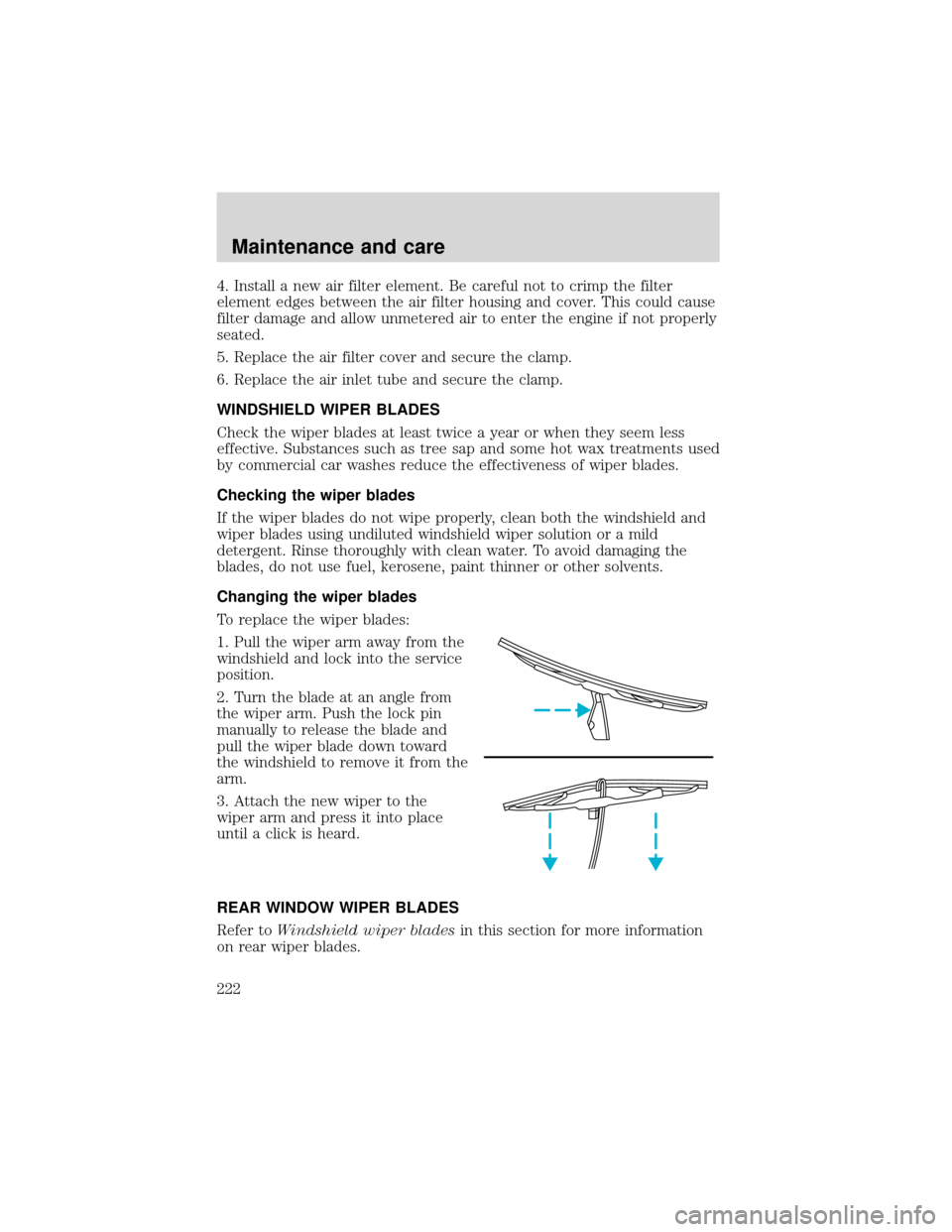
4. Install a new air filter element. Be careful not to crimp the filter
element edges between the air filter housing and cover. This could cause
filter damage and allow unmetered air to enter the engine if not properly
seated.
5. Replace the air filter cover and secure the clamp.
6. Replace the air inlet tube and secure the clamp.
WINDSHIELD WIPER BLADES
Check the wiper blades at least twice a year or when they seem less
effective. Substances such as tree sap and some hot wax treatments used
by commercial car washes reduce the effectiveness of wiper blades.
Checking the wiper blades
If the wiper blades do not wipe properly, clean both the windshield and
wiper blades using undiluted windshield wiper solution or a mild
detergent. Rinse thoroughly with clean water. To avoid damaging the
blades, do not use fuel, kerosene, paint thinner or other solvents.
Changing the wiper blades
To replace the wiper blades:
1. Pull the wiper arm away from the
windshield and lock into the service
position.
2. Turn the blade at an angle from
the wiper arm. Push the lock pin
manually to release the blade and
pull the wiper blade down toward
the windshield to remove it from the
arm.
3. Attach the new wiper to the
wiper arm and press it into place
until a click is heard.
REAR WINDOW WIPER BLADES
Refer toWindshield wiper bladesin this section for more information
on rear wiper blades.
Maintenance and care
222
Page 234 of 280
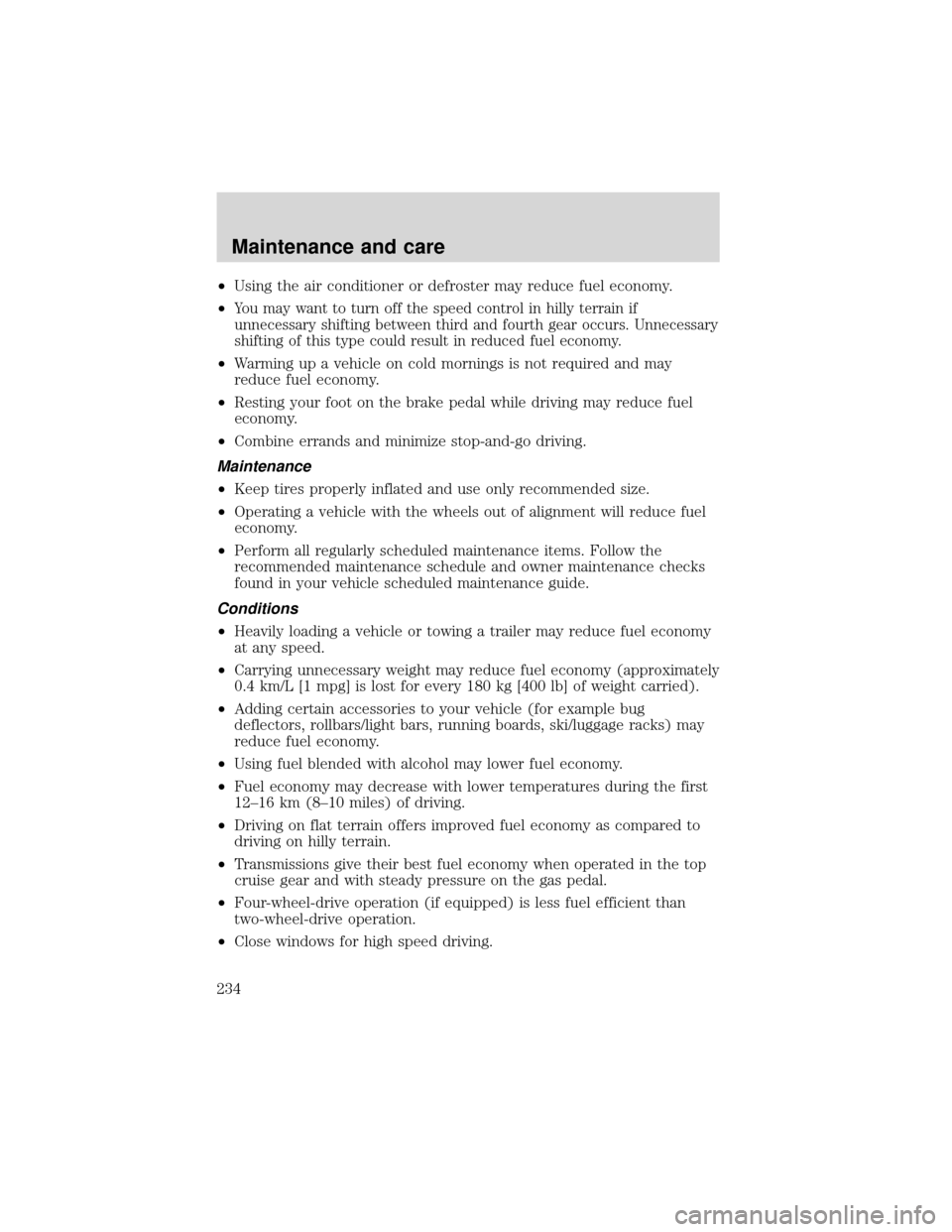
•Using the air conditioner or defroster may reduce fuel economy.
•
You may want to turn off the speed control in hilly terrain if
unnecessary shifting between third and fourth gear occurs. Unnecessary
shifting of this type could result in reduced fuel economy.
•Warming up a vehicle on cold mornings is not required and may
reduce fuel economy.
•Resting your foot on the brake pedal while driving may reduce fuel
economy.
•Combine errands and minimize stop-and-go driving.
Maintenance
•Keep tires properly inflated and use only recommended size.
•Operating a vehicle with the wheels out of alignment will reduce fuel
economy.
•Perform all regularly scheduled maintenance items. Follow the
recommended maintenance schedule and owner maintenance checks
found in your vehicle scheduled maintenance guide.
Conditions
•Heavily loading a vehicle or towing a trailer may reduce fuel economy
at any speed.
•Carrying unnecessary weight may reduce fuel economy (approximately
0.4 km/L [1 mpg] is lost for every 180 kg [400 lb] of weight carried).
•Adding certain accessories to your vehicle (for example bug
deflectors, rollbars/light bars, running boards, ski/luggage racks) may
reduce fuel economy.
•Using fuel blended with alcohol may lower fuel economy.
•Fuel economy may decrease with lower temperatures during the first
12–16 km (8–10 miles) of driving.
•Driving on flat terrain offers improved fuel economy as compared to
driving on hilly terrain.
•Transmissions give their best fuel economy when operated in the top
cruise gear and with steady pressure on the gas pedal.
•Four-wheel-drive operation (if equipped) is less fuel efficient than
two-wheel-drive operation.
•Close windows for high speed driving.
Maintenance and care
234
Page 235 of 280
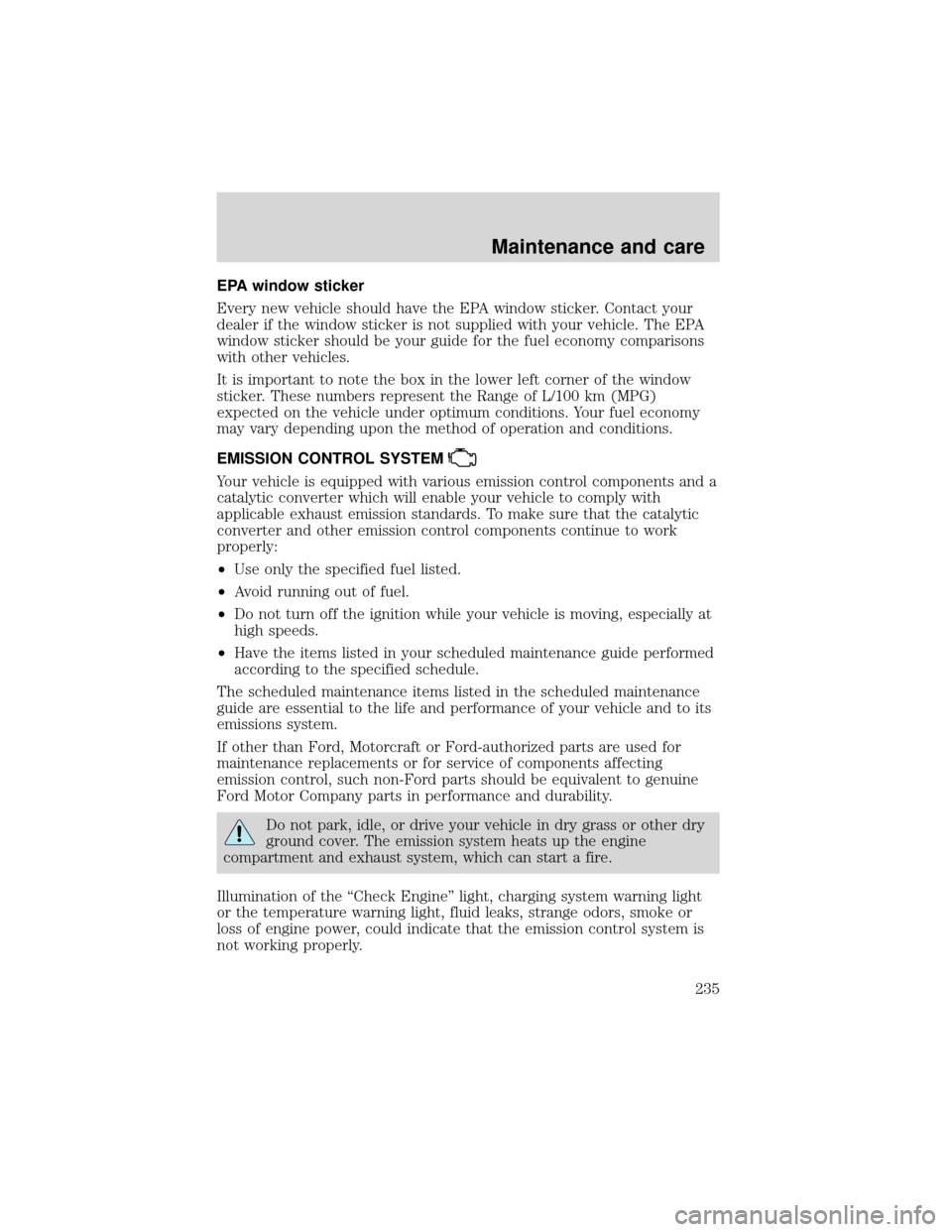
EPA window sticker
Every new vehicle should have the EPA window sticker. Contact your
dealer if the window sticker is not supplied with your vehicle. The EPA
window sticker should be your guide for the fuel economy comparisons
with other vehicles.
It is important to note the box in the lower left corner of the window
sticker. These numbers represent the Range of L/100 km (MPG)
expected on the vehicle under optimum conditions. Your fuel economy
may vary depending upon the method of operation and conditions.
EMISSION CONTROL SYSTEM
Your vehicle is equipped with various emission control components and a
catalytic converter which will enable your vehicle to comply with
applicable exhaust emission standards. To make sure that the catalytic
converter and other emission control components continue to work
properly:
•Use only the specified fuel listed.
•Avoid running out of fuel.
•Do not turn off the ignition while your vehicle is moving, especially at
high speeds.
•Have the items listed in your scheduled maintenance guide performed
according to the specified schedule.
The scheduled maintenance items listed in the scheduled maintenance
guide are essential to the life and performance of your vehicle and to its
emissions system.
If other than Ford, Motorcraft or Ford-authorized parts are used for
maintenance replacements or for service of components affecting
emission control, such non-Ford parts should be equivalent to genuine
Ford Motor Company parts in performance and durability.
Do not park, idle, or drive your vehicle in dry grass or other dry
ground cover. The emission system heats up the engine
compartment and exhaust system, which can start a fire.
Illumination of the“Check Engine”light, charging system warning light
or the temperature warning light, fluid leaks, strange odors, smoke or
loss of engine power, could indicate that the emission control system is
not working properly.
Maintenance and care
235
Page 245 of 280
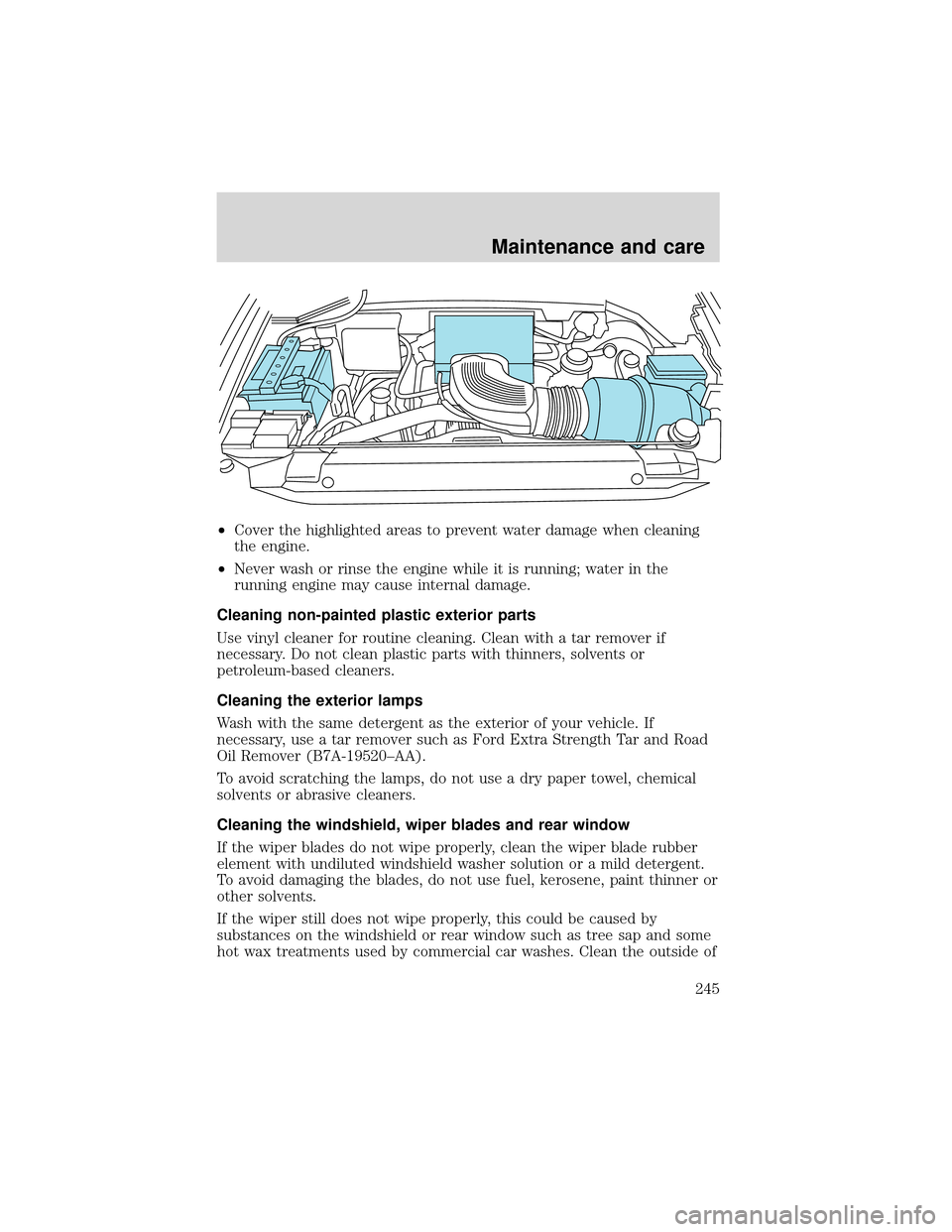
•Cover the highlighted areas to prevent water damage when cleaning
the engine.
•Never wash or rinse the engine while it is running; water in the
running engine may cause internal damage.
Cleaning non-painted plastic exterior parts
Use vinyl cleaner for routine cleaning. Clean with a tar remover if
necessary. Do not clean plastic parts with thinners, solvents or
petroleum-based cleaners.
Cleaning the exterior lamps
Wash with the same detergent as the exterior of your vehicle. If
necessary, use a tar remover such as Ford Extra Strength Tar and Road
Oil Remover (B7A-19520–AA).
To avoid scratching the lamps, do not use a dry paper towel, chemical
solvents or abrasive cleaners.
Cleaning the windshield, wiper blades and rear window
If the wiper blades do not wipe properly, clean the wiper blade rubber
element with undiluted windshield washer solution or a mild detergent.
To avoid damaging the blades, do not use fuel, kerosene, paint thinner or
other solvents.
If the wiper still does not wipe properly, this could be caused by
substances on the windshield or rear window such as tree sap and some
hot wax treatments used by commercial car washes. Clean the outside of
Maintenance and care
245
Page 246 of 280
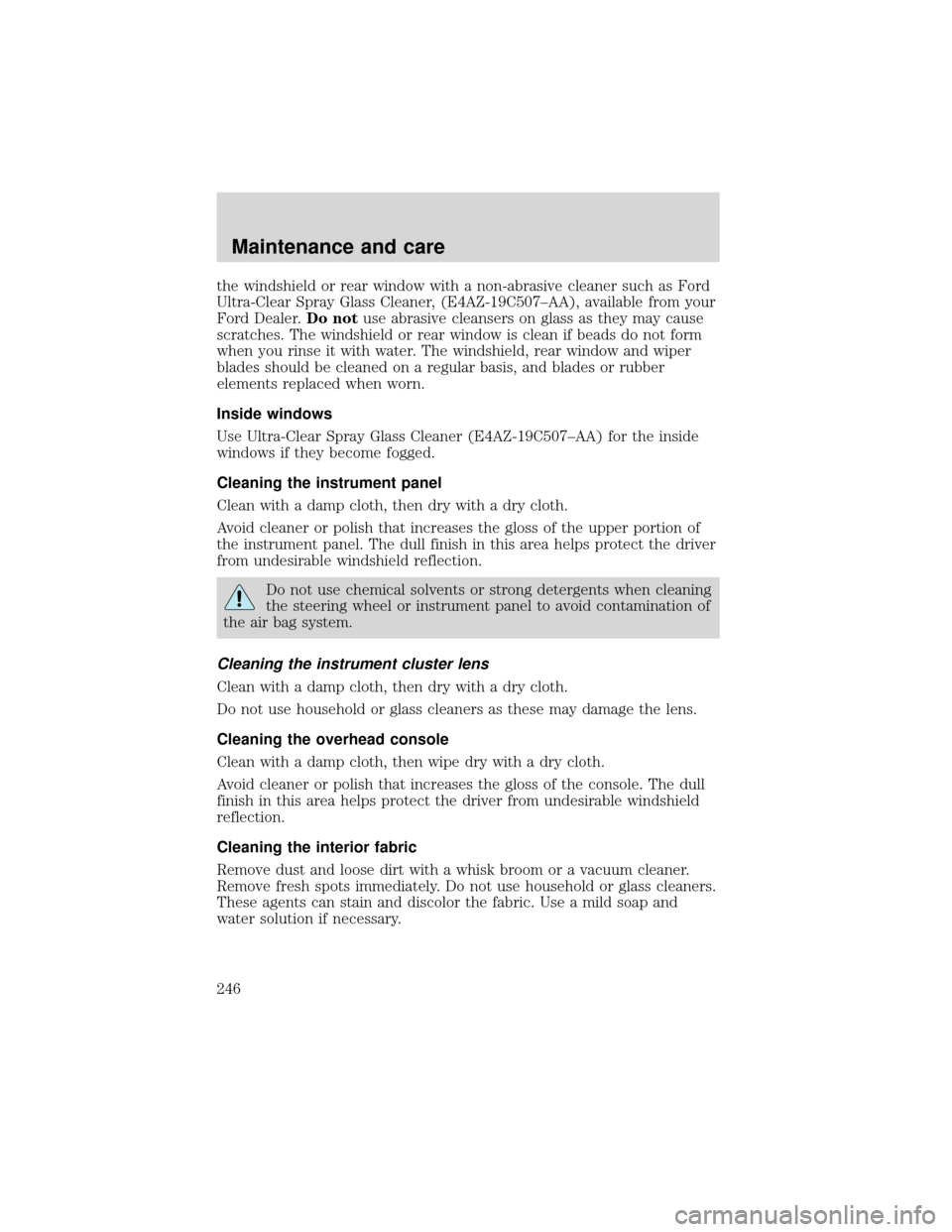
the windshield or rear window with a non-abrasive cleaner such as Ford
Ultra-Clear Spray Glass Cleaner, (E4AZ-19C507–AA), available from your
Ford Dealer.Do notuse abrasive cleansers on glass as they may cause
scratches. The windshield or rear window is clean if beads do not form
when you rinse it with water. The windshield, rear window and wiper
blades should be cleaned on a regular basis, and blades or rubber
elements replaced when worn.
Inside windows
Use Ultra-Clear Spray Glass Cleaner (E4AZ-19C507–AA) for the inside
windows if they become fogged.
Cleaning the instrument panel
Clean with a damp cloth, then dry with a dry cloth.
Avoid cleaner or polish that increases the gloss of the upper portion of
the instrument panel. The dull finish in this area helps protect the driver
from undesirable windshield reflection.
Do not use chemical solvents or strong detergents when cleaning
the steering wheel or instrument panel to avoid contamination of
the air bag system.
Cleaning the instrument cluster lens
Clean with a damp cloth, then dry with a dry cloth.
Do not use household or glass cleaners as these may damage the lens.
Cleaning the overhead console
Clean with a damp cloth, then wipe dry with a dry cloth.
Avoid cleaner or polish that increases the gloss of the console. The dull
finish in this area helps protect the driver from undesirable windshield
reflection.
Cleaning the interior fabric
Remove dust and loose dirt with a whisk broom or a vacuum cleaner.
Remove fresh spots immediately. Do not use household or glass cleaners.
These agents can stain and discolor the fabric. Use a mild soap and
water solution if necessary.
Maintenance and care
246
Page 267 of 280
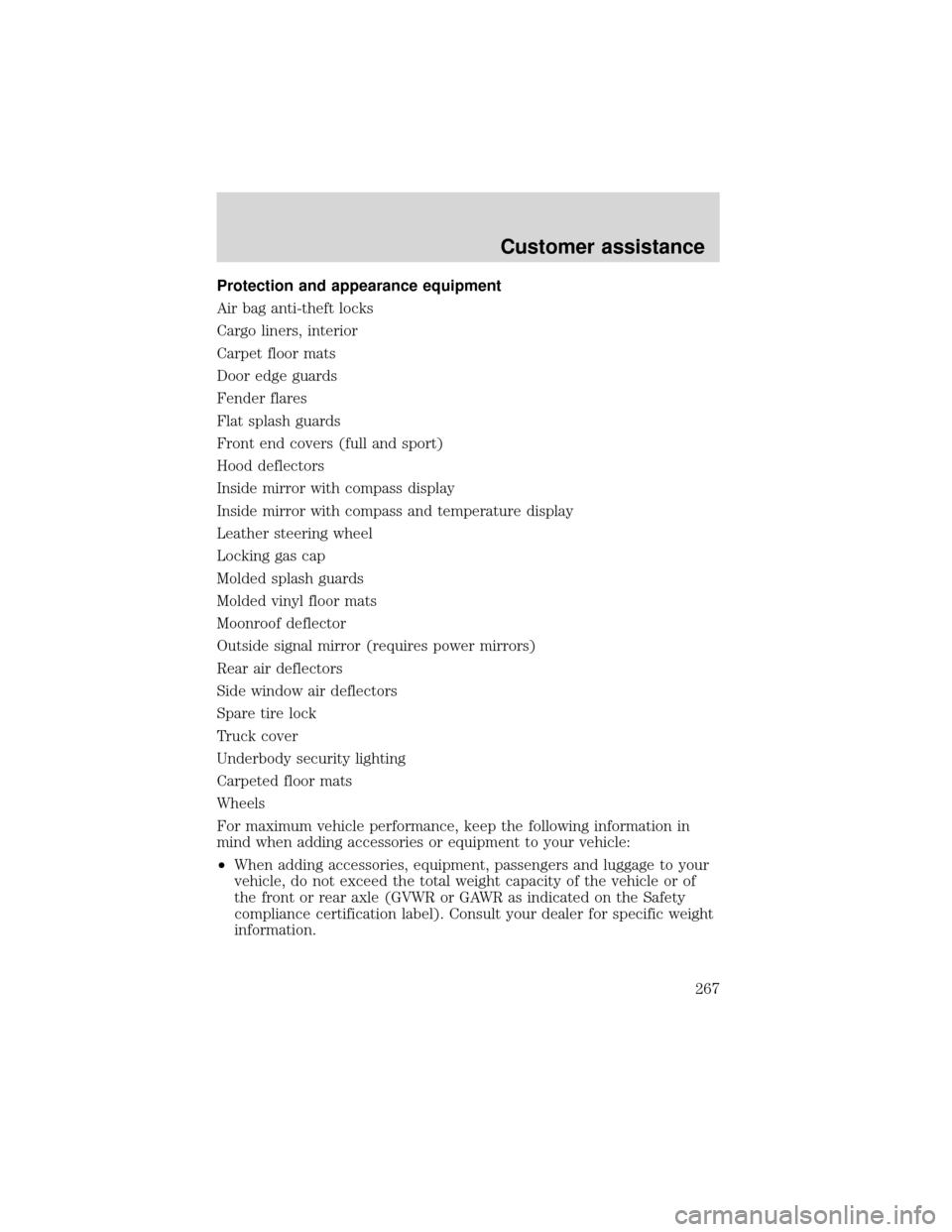
Protection and appearance equipment
Air bag anti-theft locks
Cargo liners, interior
Carpet floor mats
Door edge guards
Fender flares
Flat splash guards
Front end covers (full and sport)
Hood deflectors
Inside mirror with compass display
Inside mirror with compass and temperature display
Leather steering wheel
Locking gas cap
Molded splash guards
Molded vinyl floor mats
Moonroof deflector
Outside signal mirror (requires power mirrors)
Rear air deflectors
Side window air deflectors
Spare tire lock
Truck cover
Underbody security lighting
Carpeted floor mats
Wheels
For maximum vehicle performance, keep the following information in
mind when adding accessories or equipment to your vehicle:
•When adding accessories, equipment, passengers and luggage to your
vehicle, do not exceed the total weight capacity of the vehicle or of
the front or rear axle (GVWR or GAWR as indicated on the Safety
compliance certification label). Consult your dealer for specific weight
information.
Customer assistance
267
Page 272 of 280
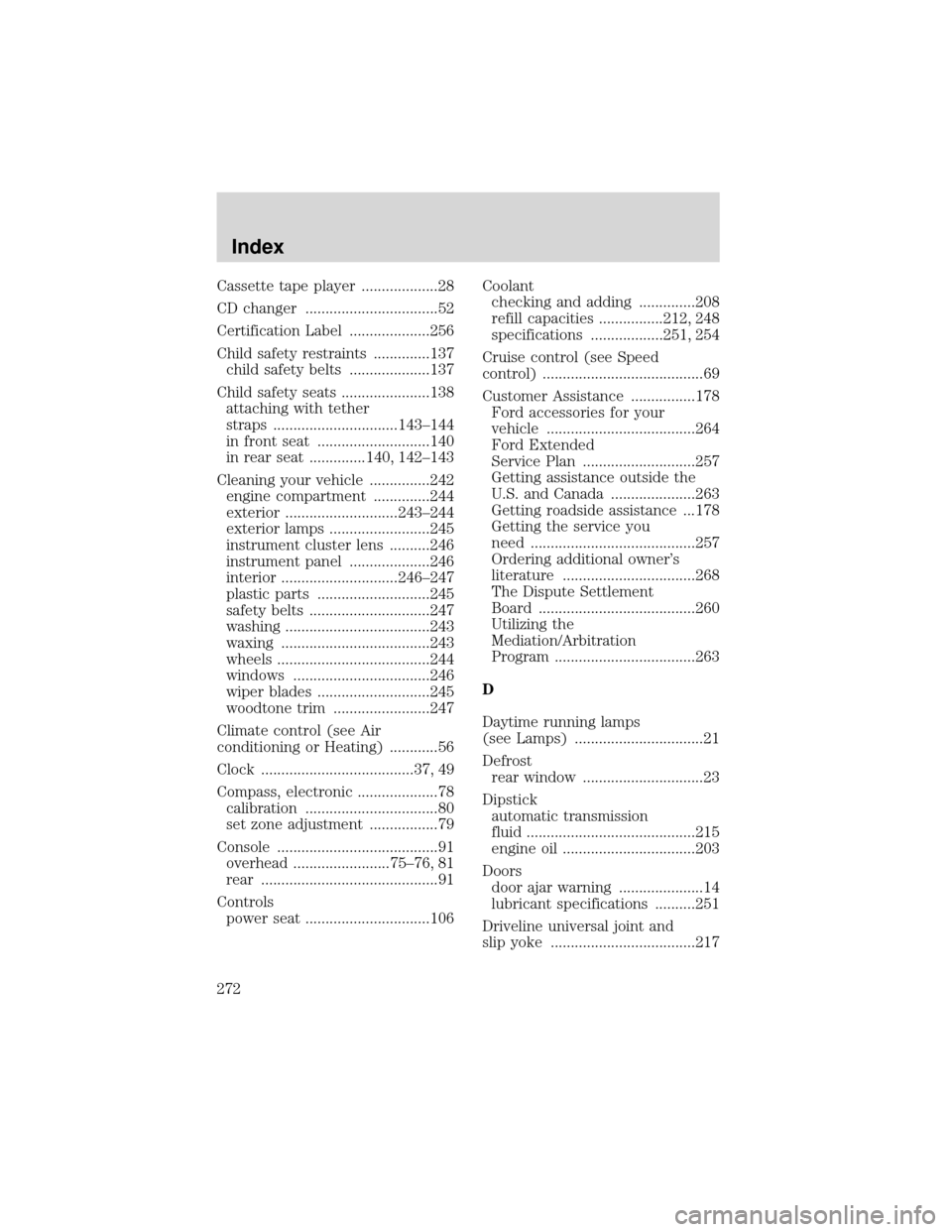
Cassette tape player ...................28
CD changer .................................52
Certification Label ....................256
Child safety restraints ..............137
child safety belts ....................137
Child safety seats ......................138
attaching with tether
straps ...............................143–144
in front seat ............................140
in rear seat ..............140, 142–143
Cleaning your vehicle ...............242
engine compartment ..............244
exterior ............................243–244
exterior lamps .........................245
instrument cluster lens ..........246
instrument panel ....................246
interior .............................246–247
plastic parts ............................245
safety belts ..............................247
washing ....................................243
waxing .....................................243
wheels ......................................244
windows ..................................246
wiper blades ............................245
woodtone trim ........................247
Climate control (see Air
conditioning or Heating) ............56
Clock ......................................37, 49
Compass, electronic ....................78
calibration .................................80
set zone adjustment .................79
Console ........................................91
overhead ........................75–76, 81
rear ............................................91
Controls
power seat ...............................106Coolant
checking and adding ..............208
refill capacities ................212, 248
specifications ..................251, 254
Cruise control (see Speed
control) ........................................69
Customer Assistance ................178
Ford accessories for your
vehicle .....................................264
Ford Extended
Service Plan ............................257
Getting assistance outside the
U.S. and Canada .....................263
Getting roadside assistance ...178
Getting the service you
need .........................................257
Ordering additional owner’s
literature .................................268
The Dispute Settlement
Board .......................................260
Utilizing the
Mediation/Arbitration
Program ...................................263
D
Daytime running lamps
(see Lamps) ................................21
Defrost
rear window ..............................23
Dipstick
automatic transmission
fluid ..........................................215
engine oil .................................203
Doors
door ajar warning .....................14
lubricant specifications ..........251
Driveline universal joint and
slip yoke ....................................217
Index
272
Page 276 of 280
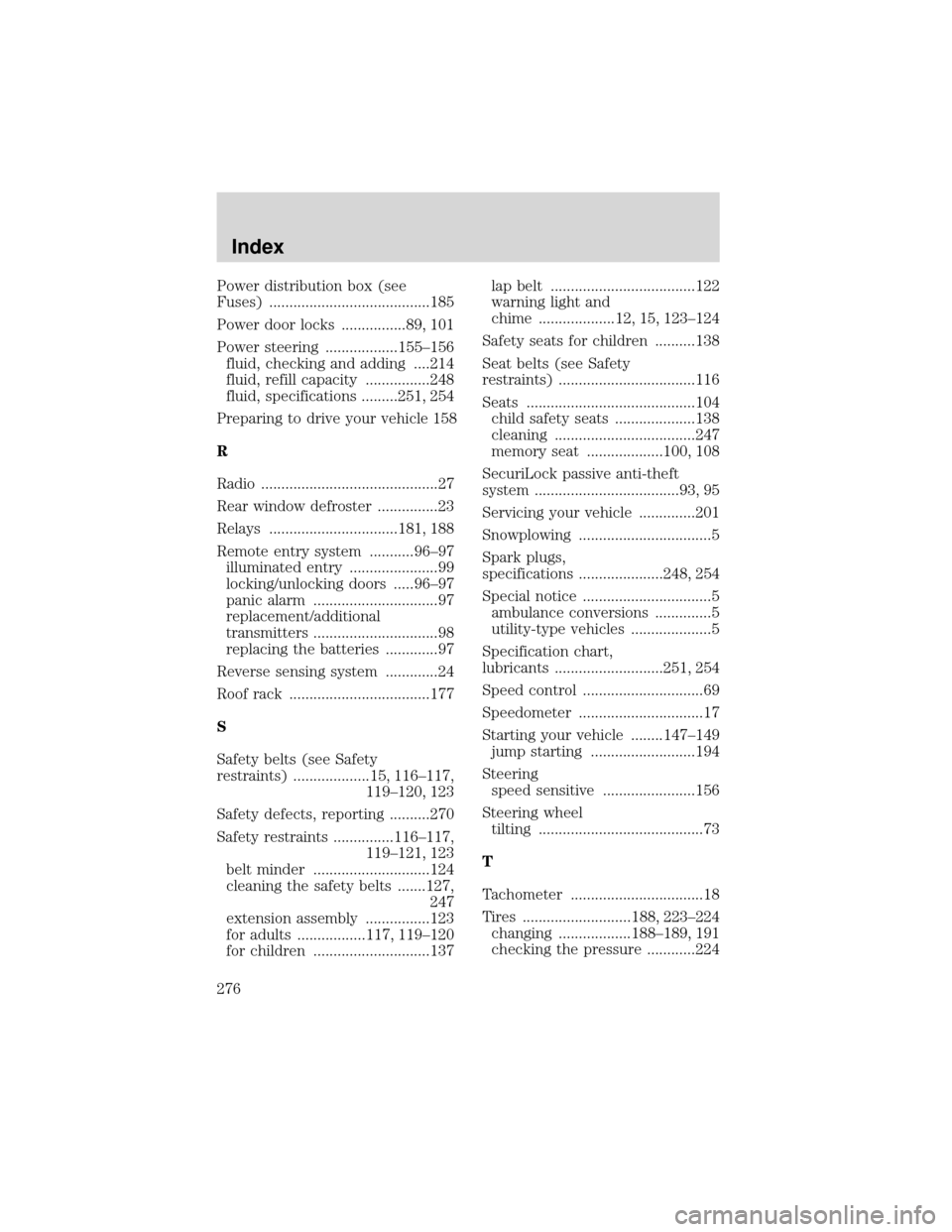
Power distribution box (see
Fuses) ........................................185
Power door locks ................89, 101
Power steering ..................155–156
fluid, checking and adding ....214
fluid, refill capacity ................248
fluid, specifications .........251, 254
Preparing to drive your vehicle 158
R
Radio ............................................27
Rear window defroster ...............23
Relays ................................181, 188
Remote entry system ...........96–97
illuminated entry ......................99
locking/unlocking doors .....96–97
panic alarm ...............................97
replacement/additional
transmitters ...............................98
replacing the batteries .............97
Reverse sensing system .............24
Roof rack ...................................177
S
Safety belts (see Safety
restraints) ...................15, 116–117,
119–120, 123
Safety defects, reporting ..........270
Safety restraints ...............116–117,
119–121, 123
belt minder .............................124
cleaning the safety belts .......127,
247
extension assembly ................123
for adults .................117, 119–120
for children .............................137lap belt ....................................122
warning light and
chime ...................12, 15, 123–124
Safety seats for children ..........138
Seat belts (see Safety
restraints) ..................................116
Seats ..........................................104
child safety seats ....................138
cleaning ...................................247
memory seat ...................100, 108
SecuriLock passive anti-theft
system ....................................93, 95
Servicing your vehicle ..............201
Snowplowing .................................5
Spark plugs,
specifications .....................248, 254
Special notice ................................5
ambulance conversions ..............5
utility-type vehicles ....................5
Specification chart,
lubricants ...........................251, 254
Speed control ..............................69
Speedometer ...............................17
Starting your vehicle ........147–149
jump starting ..........................194
Steering
speed sensitive .......................156
Steering wheel
tilting .........................................73
T
Tachometer .................................18
Tires ...........................188, 223–224
changing ..................188–189, 191
checking the pressure ............224
Index
276